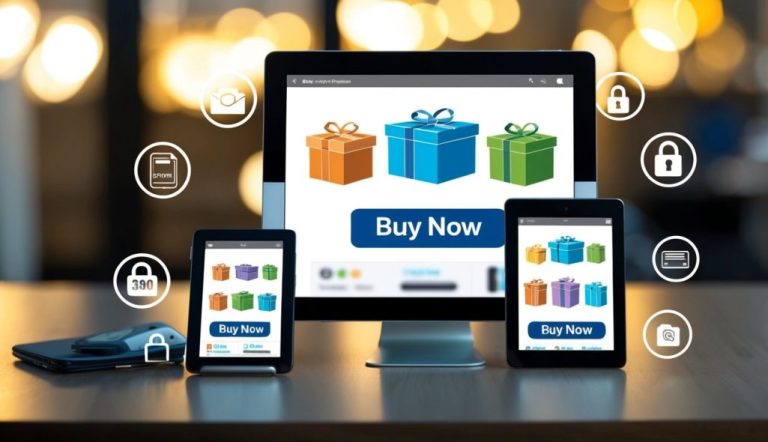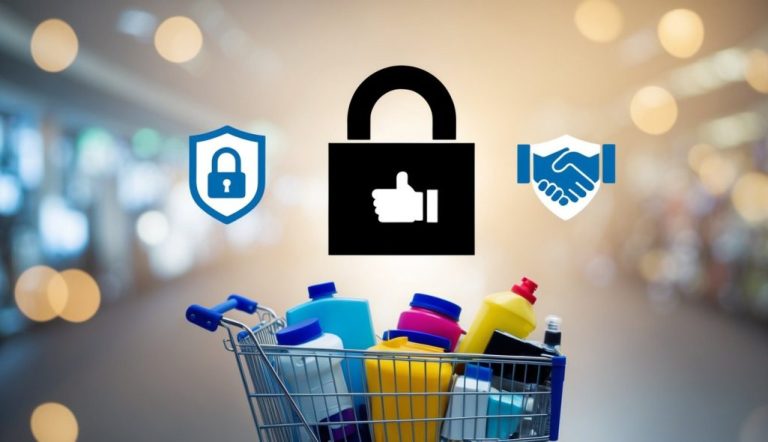Seasonal e-commerce marketing offers a unique opportunity to boost your sales and connect with customers in meaningful ways. Understanding how to effectively harness these times can transform your business. Maximizing seasonal promotions is key to driving increased consumer spending and enhancing brand visibility.

Engaging marketing content tailored to seasonal themes can capture customer attention and drive conversions. This includes everything from email campaigns to social media strategies designed to tap into seasonal interests. Optimizing your online shopping experience during these peak times can make a significant difference in your revenues.
To truly succeed in seasonal marketing, you must plan strategic campaigns that align with your brand and customer expectations. From leveraging advanced sales strategies to implementing successful product launches, your ability to adapt and innovate can set you apart in the crowded e-commerce landscape.
Key Takeaways
- Focus on crafting engaging seasonal content.
- Maximize sales through strategic promotions.
- Optimize online shopping experiences for customers.
Understanding Seasonal E-Commerce Marketing
Grasping the essence of seasonal e-commerce marketing is crucial for enhancing sales and customer engagement. You’ll explore why seasonality matters and how to identify key seasonal milestones that can impact your marketing strategies.
The Importance of Seasonality in E-Commerce
Seasonality plays a pivotal role in e-commerce by influencing when and how consumers are likely to make purchases. Certain times of the year, like the holiday season or specific events such as Black Friday, trigger spikes in consumer activity. During these periods, shoppers are more inclined to spend, either for gifting or finding deals.
Understanding the rhythm of seasons helps you align inventory and promotions accordingly. Seasons like Christmas and Halloween encourage themed product lines, while Mother’s Day and Valentine’s Day often focus on personalized gifts.
Being mindful of seasons allows you to target campaigns effectively, ensuring you deliver relevant products to meet rising demand. This strategic alignment increases the chances of capturing consumer interest and driving purchases during peak times.
Identifying Key Seasonal Milestones
Recognizing key seasonal milestones is essential for synchronizing your marketing efforts with consumer expectations. Seasons such as spring and summer bring unique promotional opportunities for items like outdoor gear or fashion. Similarly, back to school and Easter present chances to target specific audience segments.
You should mark events like the start of winter or fall when products suited to colder weather become more sought after. Analyzing historical data can help spot patterns where certain products trend during specific seasons. This approach lets you anticipate demand shifts and adjust stock levels accordingly.
By pinpointing these milestones, you can tailor marketing strategies to optimize visibility and engagement. Season-specific promotions and content help position your brand as responsive and relevant throughout the year.
Strategic Campaign Planning
Strategic campaign planning is important for successful e-commerce marketing. Creating a marketing calendar and properly segmenting your customers are vital steps to tailor your message to different customer needs and seasons. Let’s explore these strategies in detail.
Developing a Marketing Calendar
A well-crafted marketing calendar is essential for organizing your campaigns throughout the year. Start by highlighting significant dates and events that align with your products and target audience. Consider holidays, special seasons, or industry-specific events that could boost your sales and visibility.
You must schedule your campaigns in advance to ensure ample preparation time. List out key actions such as content creation, promotion schedules, and launch dates. This will help maintain consistency and allow you to anticipate potential challenges or opportunities. Regularly update this calendar to reflect any changes or new opportunities.
Customer Segmentation for Targeted Campaigns
Customer segmentation helps you tailor marketing efforts to specific groups. Start by analyzing customer data to identify distinct segments based on demographics, purchasing behavior, or preferences. This allows you to create campaigns that address the unique needs and interests of different groups.
By targeting specific segments, you enhance the relevance of your messaging. For example, offering exclusive deals to repeat customers can encourage loyalty, while introducing new arrivals to first-time buyers can increase engagement. Detailed customer profiles enable you to refine your approach, making your campaigns more effective. Use insights from strategies like successful seasonal marketing to ensure your approach is impactful and resonates with your audience.
Crafting Engaging Marketing Content
Creating engaging marketing content involves aligning your strategies with seasonal trends to capture attention and foster connection. By using targeted content marketing and digital PR, you can maximize your reach during peak seasons, enhance visibility, and drive sales.
Content Marketing Tricks for Seasonal Relevance
To make your content resonate during special times of the year, it’s important to tailor it specifically for each season. Emphasize engaging visuals and themed messaging that align with current consumer interests.
Incorporate seasonal keywords in your blogs or social media posts to improve visibility. Use tools like Google Trends to identify trending terms or phrases. Regularly update your content to reflect changes in consumer behavior and ensure it remains relevant.
An effective seasonal content strategy includes using email marketing to reach your audience with special offers or themed newsletters. Personalize emails based on past purchase history to increase engagement. Segmenting your email list lets you send targeted offers, making your content more appealing.
Leveraging Digital PR during Peak Seasons
Digital PR can significantly boost your brand’s visibility, especially during seasons when consumer activity is high. Use press releases to announce seasonal promotions or new product launches.
Collaborate with online publications or influential blogs to reach larger audiences. Engage with influencers who align with your brand values. They can share your message and amplify reach on social media platforms.
Create shareable content that is visually appealing and seasonally relevant. This could include videos, infographics, or hashtag campaigns.
Consider hosting seasonal events or webinars to connect with your audience directly. These can be virtual or in-person and serve as a way for people to engage with your brand on a deeper level. By thoughtfully integrating digital PR efforts during peak times, you strengthen your brand’s presence and market reach.
Maximizing Sales with Seasonal Promotions
To boost sales during seasonal promotions, you can use tactics like limited-time offers and exclusive discounts. These methods create urgency, encouraging customers to make quicker purchasing decisions.
Creating Urgency with Limited-Time Offers
Limited-time offers can create a strong sense of urgency. By letting customers know they have a short window to act, you can motivate them to complete a purchase quickly. This strategy is effective during peak shopping times, as it taps into the fear of missing out.
Consider using countdown timers on your website. These visual cues highlight how much time is left for a sale and can push potential buyers to act faster. Flash sales are another great option, offering deep discounts for just a few hours.
Rewarding customers who act fast with extra bonuses, like free shipping or a small gift, can also be beneficial. Making these offers exclusive to your email list or social media followers adds a layer of exclusivity.
Exclusive Deals and Discounts
Exclusive deals grab attention by offering something special that customers can’t get elsewhere. Personalizing these promotions can make them even more enticing, as people love feeling valued.
You can create loyalty programs that reward repeat customers. Offering points or discounts for every purchase encourages them to keep coming back. Partnering with popular influencers can also extend your reach and give your promotions more credibility.
Highlighting these exclusive offers through vibrant banners on your website or app makes them stand out. Use push notifications to remind customers about their special status or an impending deadline to use their exclusive deal.
Optimizing Online Shopping Experiences
In seasonal e-commerce, enhancing user experience and offering personalized product recommendations are crucial. These strategies help retain customers and boost sales during high-traffic periods.
Improving UX for Seasonal Shoppers
For seasonal shoppers, a seamless user experience is essential. Ensure your website loads quickly, especially during peak times, to prevent losing impatient customers. Simplify navigation with clear categories and search functions to help users find what they need easily.
Use engaging visuals and concise product information. Highlight special seasonal offers and provide customer reviews for added credibility.
Mobile optimization is key, as many shoppers use smartphones for purchases. Implement intuitive design, ensuring clickable buttons and easy access to shopping carts. Addressing these factors enhances the overall shopping experience and keeps users engaged.
Personalized Product Recommendations
Personalized product recommendations can significantly influence buying decisions. Use past purchase data and browsing history to suggest items that match user interests.
Incorporate machine learning algorithms to refine recommendations further, predicting what users may want next.
Emails tailored with these suggestions boost engagement and conversions. Highlight holiday-themed products or discounts that can entice seasonal shoppers.
Cross-selling by showing related products on product pages encourages additional purchases. This approach not only increases sales but also creates a more satisfying shopping experience by showing customers that you understand their preferences. Incorporating such strategies effectively can keep customers coming back, enhancing your sales performance during seasonal peaks.
Engaging Customers Through Social Media
To make the most of seasonal e-commerce campaigns, you can effectively use social media to connect with your audience. Different platforms have unique features, and coordinating these with your seasonal plans can increase engagement and sales.
Strategies for Different Platforms
On Facebook, using targeted ads can help you reach specific demographics. Create engaging content like polls and contests to increase interaction.
For Instagram, visual content is key. Share eye-catching images and stories that reflect the current season, and use shopping tags to make purchasing easy.
Twitter can help with quick updates and customer service. Use hashtags related to seasons or promotions to join trending conversations.
On Pinterest, create curated boards for seasonal products. This platform excels in inspiring users and driving traffic to your site.
Integrating Social Media with Seasonal Campaigns
To integrate social media into your seasonal campaigns, start with a clear plan for each platform. Align your messaging and visuals with the current season to create a cohesive campaign.
Use a content calendar to schedule posts that build anticipation and highlight special offers. Engaging videos or stories showing product uses can encourage purchases.
Harness the power of influencers to broaden your reach. Collaborate with those who align with your brand and seasonal theme.
Finally, monitor the performance of your campaigns through analytics. Adjust strategies as needed to maximize engagement and sales throughout the campaign period.
Leveraging Email Campaigns for Retention and Conversion
Using email campaigns can significantly boost both customer retention and conversions. By focusing on segmenting your audience effectively and refining your content through A/B testing, you can create more engaging emails that speak directly to your customers’ needs and preferences.
Segmented Email Marketing Strategies
One of the most effective ways to improve the success of your email campaigns is through segmentation. By dividing your email list based on customer data such as past purchases, browsing behavior, or demographics, you can tailor your messages to resonate with specific groups.
This approach not only increases the relevance of your emails but also fosters brand loyalty by showing customers that you understand their individual preferences.
For example, sending personalized product recommendations can boost engagement. Segmentation allows you to address customers by their real interests. This might involve offering special promotions to those who frequently abandon carts or providing early access to sales for loyal customers.
By utilizing segmentation in your email marketing, you can ensure that your messages are more targeted, resulting in higher conversion rates.
Effective A/B Testing of Email Content
A/B testing is crucial in refining your email content to maximize engagement and conversion. This process involves creating two versions of an email to see which one performs better in terms of open rates, click-through rates, or other key metrics.
It allows you to test various elements like subject lines, images, or call-to-action buttons.
Testing different subject lines can reveal what encourages your audience to open an email. Similarly, experimenting with layouts and designs can highlight what keeps their attention.
Consider setting clear goals for each test to ensure meaningful results. Regular A/B testing helps you optimize your email campaigns based on actual data, leading to greater effectiveness in retaining customers and driving conversions.
Leveraging Advanced Sales Strategies
To boost your seasonal e-commerce sales, you need to use advanced sales strategies like upselling and cross-selling to increase purchase value and enhance customer engagement which can lead to repeat business. Retargeting helps bring back interested buyers, improving conversion rates.
Upselling and Cross-Selling Techniques
Use upselling to encourage customers to buy a more expensive item or add features. Offer products with better specs at a slight increase in price.
For instance, if a customer is looking at a basic smartphone, suggest the next model up with more storage.
Cross-selling involves suggesting related products. If someone buys a camera, recommend accessories like lenses or memory cards.
This strategy not only increases sales but also enhances the shopping experience by providing convenience.
Bundle offers can make cross-selling more appealing. Offer discounts on package deals, like a shoe buyer getting a reduced price on socks.
This approach can lead to a higher average order value and foster customer loyalty.
Customer Engagement and Retargeting
Focus on customer engagement by creating personalized experiences. Use email campaigns with tailored recommendations based on past purchases.
Engaging content, like interactive quizzes, can help maintain interest and guide purchase decisions.
Implement retargeting strategies to bring back potential customers who didn’t complete purchases. Use ads on social media platforms that remind visitors of the products they viewed but didn’t buy.
These targeted ads keep your brand top-of-mind and increase the chance of conversions.
Offer incentives, like free shipping on retargeted ads, to encourage customers to complete their transactions.
Such strategies can significantly boost conversion rates and build a loyal customer base.
Implementing Successful Seasonal Product Launches
Implementing successful seasonal product launches involves well-timed releases and leveraging consumer psychology. Key strategies include scheduling product drops strategically and using tactics like countdown timers and FOMO to boost engagement and sales.
Planning Timely Product Releases
Timing is crucial for seasonal product launches. Align releases with key dates like holidays or back-to-school periods.
Consider pre-launch activities to build anticipation, such as sneak peeks or teaser campaigns.
Analyze customer preferences and seasonal trends to determine the best time for your product. Evaluate past sales data and competitor launches to avoid clashes and identify opportunities for niche markets.
Plan how to manage inventory, as seasonal items often require quick turnover. Coordinate logistics in advance to ensure timely restocks and deliveries.
Using a calendar can help organize these schedules. Highlight relevant public events and holidays to match product launches to peak shopping periods.
Utilize social media and email marketing to announce upcoming releases and keep customers engaged throughout the season.
Utilizing Countdowns and the Fear of Missing Out (FOMO)
Countdown timers are an effective way to spark interest in seasonal product launches. They create urgency, encouraging customers to act quickly before time runs out.
Display countdowns prominently on your website and in marketing materials. This visual cue signals limited availability, driving immediate engagement.
FOMO can also motivate customers. Highlight exclusive offers or limited edition items in your announcements. Showcase positive customer reviews and testimonials to enhance credibility and create desire.
Personalize messages based on customer behaviors. Send targeted notifications or reminders through email and social media.
This personalization fosters a connection with your audience, increasing the chances of conversions and sales during peak buying times.
Using these tactics smartly can amplify the impact of your seasonal e-commerce strategies.
Frequently Asked Questions
During peak e-commerce seasons, using effective marketing strategies is crucial. Tailoring advertising campaigns to seasonal trends, creating engaging content, and optimizing for search engines can drive more sales. Here’s how you can make the most of these opportunities.
What are effective strategies for e-commerce marketing during peak seasons?
Effective strategies include analyzing past seasonal data to predict trends and tailoring promotions to customer preferences.
Offering limited-time discounts and creating exclusive products can also capture attention and boost sales.
How can businesses tailor their advertising campaigns to take advantage of seasonal trends?
Businesses can tailor their campaigns by highlighting season-specific themes and using relevant imagery.
Adjusting ad spend to peak shopping times and targeting ads to customers interested in seasonal items can maximize impact.
What are some best practices for creating compelling seasonal content for e-commerce websites?
To create compelling content, use festive themes and highlight holiday-related products.
Engaging visuals and storytelling can attract visitors, while clear calls to action encourage purchases. Regular updates keep content fresh and relevant.
How can e-commerce sites optimize their SEO for seasonal products and promotions?
Optimize your SEO by using seasonal keywords and phrases. Ensure product pages are updated with relevant content, and include clear, engaging meta descriptions.
Creating blog posts on seasonal topics can also improve visibility.
In what ways can e-commerce businesses use email marketing to boost seasonal sales?
Utilize email marketing by sending personalized offers and reminders of limited-time deals.
Segment your audience to ensure the right messages reach the right people. Holiday-themed newsletters can keep your brand top-of-mind.
What social media strategies should e-commerce brands consider for promoting seasonal goods?
E-commerce brands should consider leveraging social media. They can do this by creating themed posts and stories. They should also engage with users through contests or challenges. Additionally, they should utilize paid ads to reach a broader audience. Collaborating with influencers can also help showcase your seasonal products.





